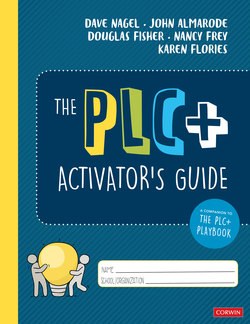Читать книгу The PLC+ Activator’s Guide - Douglas Fisher - Страница 13
На сайте Литреса книга снята с продажи.
Nine Ways to Build Collaborative Maturity
Оглавление1 Be prepared: The team will follow your lead. If you are prepared and ready to lead the meeting, the chances your peers will be invested immediately increase dramatically. For example, the summary activity in Table 1.1 will help prepare you to activate the four PLC+ crosscutting values. As you and your PLC+ move forward, delegating that preparation list will help build capacity within the team.
2 Provide a time for people to let it out: Teachers need time to vent, share personal issues, and talk about their day. Sometimes their PLC meeting is the only time they get to talk with adults. A simple strategy? Allow five minutes at the beginning of the meeting for team members to share happenings in their lives. It’s important to set an external timer so there is an indicator when the five minutes are up and to signal that it’s now time to get to business.
3 Establish routines and authentically stick to them: Maintain a professional tone at all times during the meeting. Refer back to your team’s establishment of norms in The PLC+ Playbook. This will help remind members that they are all part of the PLC+ team and collectively invested in the norms you created together.
4 Share leadership and ownership of meetings: Provide time for other members to be responsible for making the meeting a success. Prior to each PLC+ meeting, give members the opportunity to help prepare for the meeting. Give them a list of choices based on the preparation needed. One strategy: develop a to-do list prior to the conclusion of each meeting. Then, sign your name next to items that you have already begun, and encourage others to sign up for the rest.
5 Be the catalyst: Using your background work from the beginning of this chapter, start developing a list of tasks or items that need to be done before the start of each meeting. Organize this list in categories by the five guiding questions. Put this list online for your PLC+ team members to see and access.
6 Being businesslike doesn’t mean being stuffy: Have a sense of humor, and make sure there are times when the meeting is fun; it’s important and allows the team to let off steam. Building efficacy requires the recognition and celebration of successes within the group. Take time to use the data and evidence generated by the five guiding questions to feed the individual and collective belief that we can and do have an impact on student learning.
7 Be comfortable with wait time: The initial activator often tries to do everything, to provide answers and solutions to every challenge that comes up in the PLC+. Be comfortable utilizing wait time when the team is digging into important questions and issues during PLC+ dialogue. This will require practice. Letting the conversation, or silence, occur may be the process needed at that moment. If the conversation or silence begins to lead toward an issue not related to teaching and learning, that is the time to render action by returning to the routines (see #3 in this list) or to modules in The PLC+ Playbook. However, being able to nudge the group back toward these requires that, as activators, we are familiar with the modules prior to the PLC+ meeting.
8 Be a servant leader: Do more than others can ever expect of you. As the initial activator, be prepared to let your own commitment to the process do the “talking.” Early on, you may have to add a few more items to your own to-do list that include developing a high level of comfort and familiarity with the protocols. Helping you achieve this knowledge was the purpose behind the previously listed “Be the Catalyst” task.
9 Take your job, not yourself, seriously: Be willing more than anyone else on the team to be humble, acknowledge mistakes, and ensure team members see you as an activator of their team and a member of the team as well at all times. The activator should be willing to put his or her data out for discussion first, using a personal reflective think aloud as a model.
What the above nine items have in common is that communication is key in the success of the meeting. Communicate before, during, and after meetings. This communication should be clear, concise, and transparent.
See The PLC+ Playbook (Module 3, page 19) and PLC+: Better Decisions and Greater Impact by Design (pages 15–17).
Reflection
Using Module 3 from The PLC+ Playbook and pages 15–17 in the core book, develop a list of things you can do to enhance credibility with your colleagues. Be specific. In fact, you may want to work through “Your Individual Identity” (on page 20 of Module 3) before moving to “Teacher Credibility” (on pages 21–24 of the same module).
______________________________________________________________________________________
______________________________________________________________________________________
______________________________________________________________________________________
______________________________________________________________________________________
______________________________________________________________________________________
______________________________________________________________________________________
______________________________________________________________________________________
______________________________________________________________________________________
______________________________________________________________________________________
______________________________________________________________________________________
______________________________________________________________________________________
______________________________________________________________________________________
______________________________________________________________________________________
